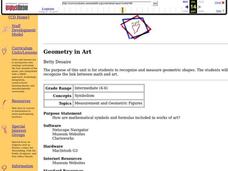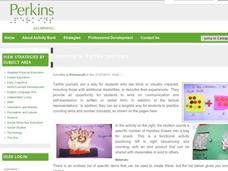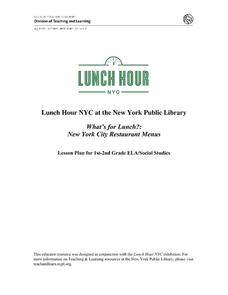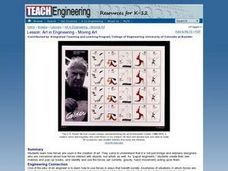Curated OER
Beef or Dairy?
Guernsey, Jersey, Holstein. Brangus, Charoloais, Herford. Here’s a truly cross-curricular resource that combines language arts, science, math, and visual arts activities as class members learn to distinguish between beef and dairy...
Curated OER
Mighty Oaks from Little Acorns
What does it mean to grow? To germinate? For the plan detailed here, class members investigate the growth process of an oak tree while focusing on the beginning stages of planting and germination. They plant seeds and record observations...
Curated OER
Calendar Art
Students assemble and decorate a calendar. This is a lesson to be used at the beginning of each month to make a calendar for the month. Math concepts for this lesson consist of each student writing numbers on the calendar.
Curated OER
Geometry in Art
Students examine mathematical symbols and formulas included in works of art. They analyze quilts for shapes and they each make their own quilt from squares using geometric shapes.
Curated OER
Mandala Art
Students investigate art elements such as color schemes and proportion by creating their own personal Mandala Circle on paper or canvas. This also allows students to investigate mathematical concepts such as tesselations or social...
Curated OER
Learn Under the Old Masters
Learners take a closer look at portraits. In this art appreciation lesson, students may visit the National Portrait Gallery, the Victoria Art Gallery, or the Scottish National Portrait Gallery online or in-person to discover works of art.
Curated OER
Totally Awesome Answers to Wacky Wonders
Middle schoolers work with a partner to gather information on a question from two sources using a computer program and the Internet. They also write a report with visuals to air on closed-circuit TV for the school. Use this lesson to...
Curated OER
Geometry Vases: Ceramics Lesson
Geometric shapes are used in math and in art. Learners discuss the various names, dimensions, and attributes of geometric shapes, then apply that knowledge to design a vase. They use 3-D shapes to make a cubist-style vase out of clay.
Education Closet
Equal Rhythms
Engage young mathematicians in learning about fractions with this cross-curricular math and music lesson. After listening to and repeating different beat patterns, children realize that musical notes are just another way of representing...
Curated OER
Tiles, Blocks, Sapphires & Gold: Designing a Treasure Map
Young cartographers in groups hide treasure at school and then create a map to find it using pattern blocks and tiles. They make paintings with clues to create a visual representation of the location of their treasure. Groups present...
Perkins School for the Blind
Counting in Tactile Journals
This is one of those great ideas I totally love. Youngsters with visual impairments practice counting and left-to -right sequencing by counting out a set number of edible objects from the left and putting them in a bag on the right. They...
Curated OER
Lesson New Museum: Exploring the Building
Explore the possibilities of buildings, public spaces, and architectural design. Learners examine the work of SANAA architects Sejima & Nishizawa through background information, images, and guided class discussion. This instructional...
Curated OER
Appalachia
Students investigate the benefits of dance and participate in dances. In this dance lesson, students investigate a number of dances such as square dancing and clogging that are native to Appalachia. They use math concepts to determine...
Curated OER
"Reviewing Facts Through 10" Lesson Plan
Explore the joy of math with you little learners! They practice creating math problems with numbers from a fact family using numbers 1-10. They work independently with a set of connecting cubes to aid them in creating number sentences...
New York Public Library
What's for Lunch?: New York City Restaurant Menus
Do you remember the days when a cup of coffee cost five cents? At A.W. Dennett restaurant in 1894, you could buy a five-cent cup of coffee and as well as a five-cent slice of pie to accompany it. The menu from that year is a primary...
August House
The Pig Who Went Home on Sunday
Turn your classroom into a pig sty with a instructional activity based on the Appalachian folktale The Pig Who Went Home on Sunday. Similar to the story of The Three Little Pigs, the folktale tells a story of four pigs who leave...
Curated OER
Beyond the AB Pattern in Dance
Students demonstrate various patterns using dance. In this expressive arts instructional activity, students are led in a warm-up to demonstrate the AAB pattern, which includes spinning and jumping. Students are broken up into groups and...
Curated OER
An Organic Work That Imitates Life
Students practice using organic and geometric forms while creating individual works of art. This creative art lesson incorporates Math concepts for a cross-curricular approach in the classroom.
Hawaiʻi State Department of Education
ABA Form in Music
Patterns happen everywhere, in music, math, and language! Fourth graders listen to the "William Tell Overture" visualizing the patterns that they hear. They then discuss and write an ABA poem that matches the ABA form found in the music...
Curated OER
Origami Ducks: Geometry, Listening, and Following Directions
Make origami ducks with your class to reinforce geometry concepts and vocabulary; develop fine motor and visual translation skills; and enrich study of Japanese culture, the pond habitat, or migration. Create a whole group "worksheet"...
Curated OER
Art in Engineering - Moving Art
Students study how forces are applied in the creation of art. They design mobiles and pop-up books while identifying which forces of nature act upon them. They look at air currents, gravity, and hand movement.
Curated OER
Jazz and Math: Rhythmic Innovations
Students compare and contrast the rhythms of marches and jazz. They watch an excerpt about Buddy Bolden from the PBS Ken Burns Jazz documentary, compare/contrast march and jazz rhythms, complete a worksheet, and notate and perform jazz...
Curated OER
"ART ZOO 'Blacks in the Westward Movement', 'What Can You Do with a Portrait', and 'Of Beetles, Worms, and Leaves of Grass'"
Students study black history, examine portraits and portrait making and create their own portraits, and investigate their natural environment. This humanities lesson provides a text that can be used to teach lessons in black...
US Department of Agriculture
Agriculture Counts
Agricultural survey and the documentation of livestock or goods was the basis for the first written language. Youngsters discuss sorting and counting, and how these skills have been used for thousands of years. They accent their class...























